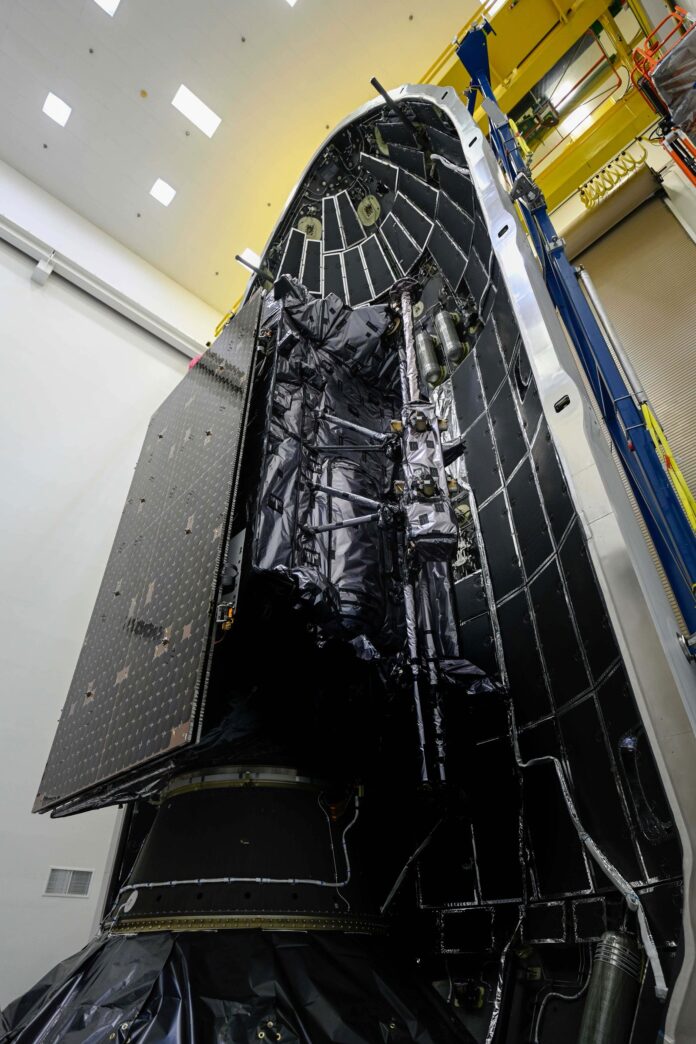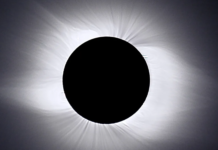Today the US Space Force launched its newest satellite, one of only a handful of the new GPS III design, which is more accurate and more resistant to interference—like signal-jamming—than its older siblings.
The launch means that more of the country’s GPS satellite constellation has stronger position, navigation, and timing abilities and is designed to live longer than its predecessors—around 15 years, by which time people not born yet could be using its services for tasks that seem sci-fi now. (Designing for the longer term also leaves less space trash to clean up.) The GPS satellite club—“GPS” being the name for the American brand of the generic “global navigation satellite system,” or GNSS—already has 31 operational members, 27 of them from three previous generations. This is only the fifth GPS III orbiter and will supplant one of the older satellites.
Everything from cell phones and smart watches to navigation systems on cars, commercial planes, and cargo ships relies on GPS. The system points the way home, pinpoints who’s nearby to swipe left on, dictates your phone’s weather forecast, and lets runners brag about their fastest miles.
As much as GPS is about position and navigation, it’s also about timing. The strict tick-tick of the satellites’ atomic clocks helps time-stamp financial transactions, track and synchronize power grids’ energy distribution, and sync the base stations that send cell signals. “It’s no longer a matter of ‘Did you use GPS today?’ but ‘How many times did you use it, whether you knew it or not?’” says Tonya Ladwig, vice president for navigation systems at Lockheed Martin, which is building the GPS III crew.
As indispensable as it has become to civilian life, strictly speaking, GPS wasn’t created for any of that: It’s currently operated by the Space Force, and it serves military ends. “That could be troops in combat. That could be movement of equipment. That could be our ships at sea doing strategic deterrence missions,” says Margaret Sullivan, materiel leader for the GPS III space vehicle program at the Space and Missile Systems Center. “That also includes aiding precision-guided munitions—on time, on target, every time.”
But since its capabilities were unleashed to the wider world, GPS has become intimately woven into our existential tapestry. “The US government realized what an enormous benefit this would be, not only to our US and allied military, but to the entire world,” says Sullivan, who estimates GPS services have contributed more than $75 billion annually to the US economy.
Yet some problems have been stitched into that tapestry, too. Older satellites have, of course, old technology, and they work in an environment that’s more treacherous than it used to be. Orbiting infrastructure—like the terrestrial sort—is vulnerable to meddling. Agents can spoof a GPS signal, creating a forgery that masquerades as the real thing, to trick, say, a ship into thinking it’s in the wrong place. Or they could jam the signal, broadcasting interference that drowns out the weak “You are here now” signal from space. Take Russian jamming of US drones over Syria. Or watch how the US’s own GPS jamming has led commercial pilots, flying in the vicinity of homeland military tests, into trouble. But troublemakers don’t have to be government operatives, just people with some extra cash and a little bit of digital know-how.
Interference is a pain if your neighbor is pranking you and your Google Maps. It’s also a problem for military operations. “If you are trying to thread your way through an unfamiliar or unfriendly environment, you need to be able to rely on accurate and available positioning to know where you are, navigation to know where you’re going, and timing to synchronize all of your operations,” says Sullivan.
“Folks have known that there are challenges with GPS for decades,” says Dana Goward, president of the Resilient Navigation and Timing Foundation, a nonprofit that in part advocates for a GPS backup, an alternative system so that we’re not so beholden to this one set of satellites. “And no system is perfect. I’m not calling the baby ugly. I’m calling the baby precious and needing of attention.”
Relatively easy interference is part of why the GPS III modernization program exists. These satellites have been in the works since 2008, when Lockheed got the contract. While the first III was originally scheduled to go to space in 2014, it was delayed until 2018. Since then, four more—including today’s launch of SV-05—have gone to orbit, although the first four only came online in 2020. It took more than a year to declare the first one operational, but timelines have sped up since then. Ladwig expects SV-05 will get the green light just a few weeks after launch.
This morning’s launch, aboard a SpaceX Falcon 9 rocket using a previously flown and refurbished rocket booster, puts into orbit the 24th GPS satellite that can beam out what’s called M-Code, a signal with beefed-up security. That’s the magic number the Space Force needs to provide full M-Code operations around the world. Or, really, Sullivan puts it this way: “It’s not magic. It’s math.” Two dozen satellites in their proper orbits can cover the whole planet.
M-code’s encryption makes it harder to spoof: Receivers on the ground can use the code itself to tell whether a signal is authentic. While the older version of the military’s protected signal is also encrypted, M-code’s cipher represents “next generation-security,” says Sullivan.
On GPS III satellites, M-Code will also be broadcast more powerfully, making it harder to jam. “Think about somebody yelling or speaking out loud to a crowd and trying to have everyone hear them,” says Ladwig. If someone else is yelling (a would-be jammer) the speaker (a GPS satellite) will have to speak louder to be heard.
But M-Code is fully useful only if users on Earth can receive it correctly, and the requisite on-the-ground infrastructure, made by defense contractor Raytheon, doesn’t quite exist yet. The company’s Next-Generation Operational Control System is years late and billions of dollars over budget. It’s now set to come online in 2023.
To stopgap the situation, Lockheed Martin was tasked with updating the Space Force’s current GPS ground-control system, which the company has sustained since 2013, to deal with M-Code Early Use (basically, the beta version). The Space Force approved the software update this required, for use in operations, in late 2020. Another upgrade allows the Space Force to control the GPS III satellites, and these—along with their M-Code–enabled older peers—accommodate global, early M-Code operations while the permanent version makes its way to completion.
Civilians won’t catch the M-Code signal, which is meant for military operations like targeting weapons, guiding aircraft, and delivering supplies. But they can nevertheless take advantage of a new one that GPS III satellites broadcast, called L1C. It’s the fourth “civil signal” out there but unique in that it is “interoperable” with broadcasts from other global navigation satellite systems, like Europe’s Galileo, Japan’s QZSS, and China’s BeiDou. A person with the right receiver could pick up signals from any of those constellations, giving even more accuracy (and a bit of backup). L1C also beams out stronger than the legacy signals.
With GPS III, regular users will also get a level-up in accuracy (if, that is, they have receivers that can make use of that detailed data—kind of like how watching TV in HD requires an HDTV). In the past, GPS has let you know your location to within about 10 to 33 feet of where you actually are. With the new sats, it’ll be more like 3 to 10 feet.
This boost happens thanks to sharper atomic clocks: A GPS receiver picks up signals from different satellites, stamped with the ultraprecise times when they were sent. The receiver can then tell how long the signals took to travel to Earth and use the difference to tell each satellite’s distance from its location. That information calculated, the receiver can spit out the spot you’re occupying on Earth, basically through fancy triangulation. The better the timestamps, the more accurate your position. Now when you’re using your GPS to drive, you can know for sure that you juuuuust missed your turn.
So how meddle-resistant and powerful is this new generation of GPS satellites? The most-cited claims, made by the Lockheed Martin makers and sometimes by the military, say that GPS III is three times more accurate, and eight times more resistant to jamming than previous GPS iterations.
But some industry observers think GPS III’s abilities aren’t as revolutionary as they might sound. “The program likely has been oversold,” says Goward. Its buzz, he continues, “is not untrue, but perhaps not as important as it might seem.” The threefold increase in accuracy won’t matter much to the average user, he argues. After all, they can intuit that they’re still on the right AllTrails track even if their dot rests a few feet from the path. “For those people who require really, really accurate GPS positioning,” like precision agriculturalists who use geospatial data to optimize their fields, says Goward, “they need down to centimeters.”
And in a recent op-ed in National Defense Magazine, former Air Force Space Command chief scientist Gene McCall contended that an eightfold anti-jamming boost would also not be enough. Even these stronger GPS signals, which have to travel thousands of miles from space, are still weak compared to the disruptive ones.
But Sullivan points out that the satellites’ security isn’t just about power; it’s also about how the signal is designed. And the on-the-ground user equipment will also have “additional anti-jam and security capabilities,” she says, “so those things work together.”
It’s been a long road to get GPS III satellites orbiting and operational, and their developmental journey isn’t over. Like the earthly objects they’re meant to guide, they’re moving ahead, but they haven’t yet arrived.
- 📩 The latest on tech, science, and more: Get our newsletters!
- What really happened when Google ousted Timnit Gebru
- Wait, vaccine lotteries actually work?
- How to turn off Amazon Sidewalk
- They rage-quit the school system—and they’re not going back
- Apple World’s full scope is coming into focus
- 👁️ Explore AI like never before with our new database
- 🎮 WIRED Games: Get the latest tips, reviews, and more
- 🏃🏽♀️ Want the best tools to get healthy? Check out our Gear team’s picks for the best fitness trackers, running gear (including shoes and socks), and best headphones








